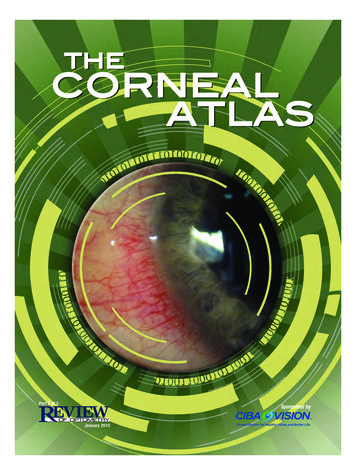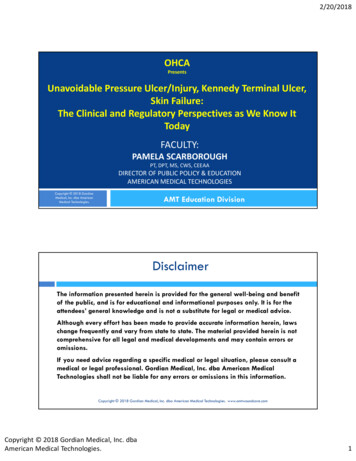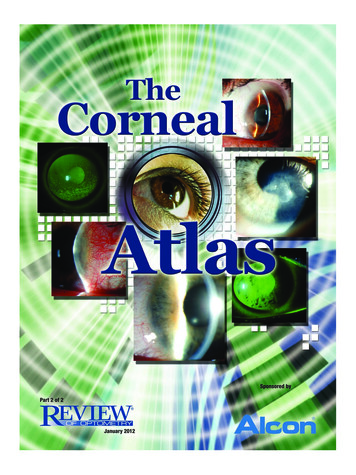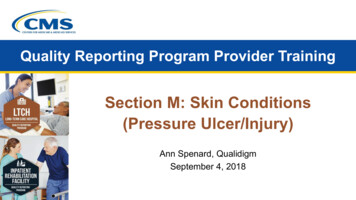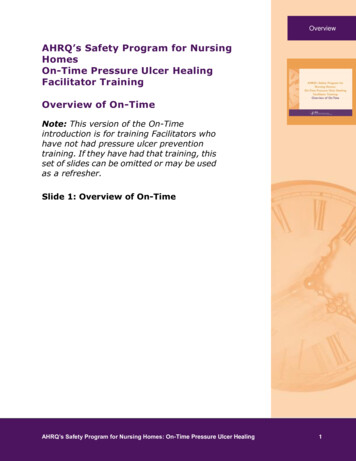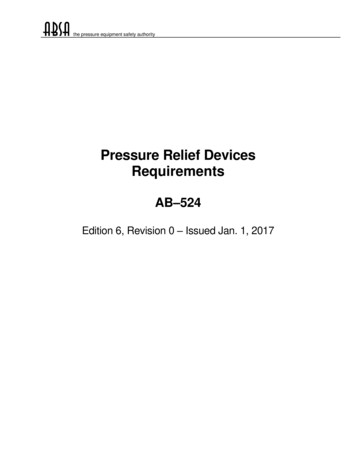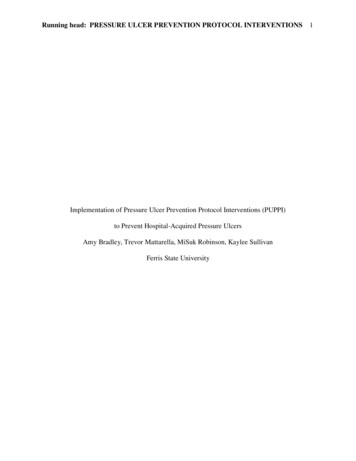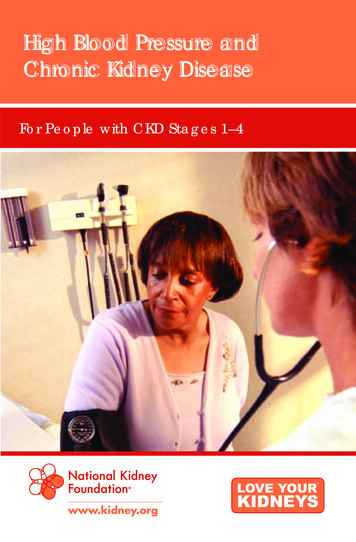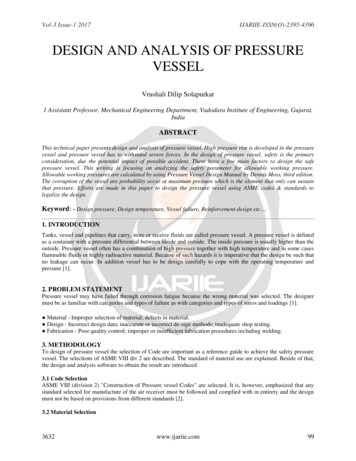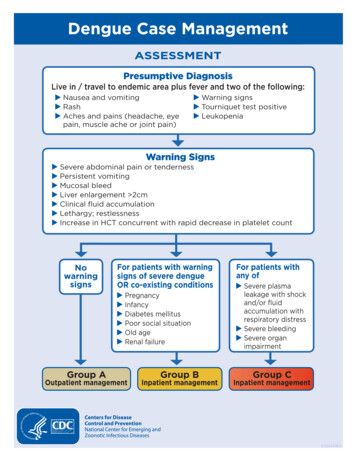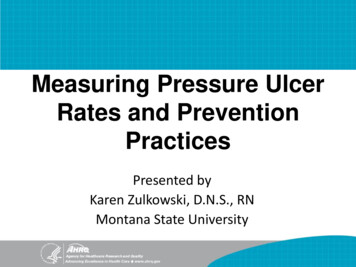
Transcription
Measuring Pressure UlcerRates and PreventionPracticesPresented byKaren Zulkowski, D.N.S., RNMontana State University
Welcome!Thank you for joining this webinar about how tomeasure pressure ulcer rates and preventionpractices.2
A Little About Myself Associate professor at MontanaState University Executive editor of the Journal of theWorld Council of EnterstomalTherapists (JWCET) and WCETInternational Ostomy Guidelines(2014) Editorial board member of OstomyWound Management and Advancesin Skin and Wound Care Legal consultant Former NPUAP board member3
Today We Will Talk About Why you look atprevalence and incidence How you calculate theserates How you look at facilitypractice Why a pressure ulcer is alearning opportunityThese topics were introduced in your 1-day training. Today,we will revisit them in depth.Please make a note of your questions. Your QualityImprovement (QI) Specialists will follow up with you afterthis webinar to address them.4
Purpose of Measurement Measuring pressure ulcer prevalence andincidence rates and looking at your preventionpractices tells you—– If there are areas in which care can be improved– If you are meeting your aims– If practice changes improve incidence– If you are sustaining improvementsIf you don’t know where you are, how do you knowif you are improving?5
16Overall PU Rates14Prevalence %12108642020072008200920102011201220132014Overall quired6.1654.64.33.63.73.9Source: Hill-Rom IPUP Survey
Acute Care1614Prevalence %12108642020072008200920102011201220132014Overall Prevalence13.413.111.911.210.49.89.59.7FA Prevalence6.4654.64.243.73.8Source: Hill-Rom IPUP Survey
Long Term Care1412Prevalence %108642020072008200920102011201220132014Overall Prevalence11.411.711.91210.810.410.612FA Prevalence3.34.95.25.55.65.24.76.4Source: Hill-Rom IPUP Survey
Long Term Acute Care40353025Prevalence %20151050Overall PrevalenceFA 1223201325201425.24.663.84.49.833.85.5Source: Hill-Rom IPUP Survey
Prevalence %Rehabilitation2520151050Source: Hill-Rom IPUP Survey20 20 20 20 20 20 20 2007 08 09 10 11 12 13 14Overall Prevalence 18.8 19.4 19 15.8 13.1 13 11 12.1FA Prevalence4.1 6.6 4.7 4.5 3.7 3.632.8
Rate of OccurrenceTwo types of measures Prevalence. Percentage of patients who have apressure ulcer in your facility today.– Calculated for each unit and overall facility Incidence. Percentage of people whodeveloped a pressure ulcer after admission toyour facility.– Calculated for each unit and overall facility– Also called facility-acquired (FA) or hospitalacquired (HA) pressure ulcers11
PrevalenceYou may have a high prevalence rate because— Your facility admits high acuity patients whoalready have a pressure ulcer before theyarrive Your facility does such a good job caring forwounds that you have many referrals forpatients who already have pressure ulcers12
Measuring Pressure Ulcer Rates What to count– Could be all stages– Could be calculated by stage– Could be Stage II and above Data needed How often to calculate How to improve data collection13
Data Needed for Pressure Ulcer RatesFor each pressure ulcer found on skinassessment, document— Name of the patientIf this is a New or Existing pressure ulcerNumber of different pressure ulcersLocation of pressure ulcersStage of deepest pressure ulcers14
Data Needed for Pressure Ulcer RatesYou’ll also need to know the number of patientson your unit or in your facility.This is easier if your hospital has a computerizedsystem.15
How Often To CalculatePressure Ulcer RatesIdeal Calculate pressure ulcer rates quarterly. Calculate same time each year.This may show seasonal variations and will givea better idea of improvement.16
How To Accomplish This Goal1. Training. You need to all be on the same pagefor identification and staging.2. Assessment. Every patient on every unit has ahead to toe skin assessment (looking forpressure ulcers).3. Record. Highest stage of pressure ulcer (eachpatient only counts once—by patient, not bynumber of wounds).4. If found. Review chart and determine if pressureulcer was documented on admission.17
PrevalenceNumber of patients with a pressure ulcerDivided byTotal number of patients (on unit or in facility)Times 100 %18
Pressure Ulcer Prevalence RateNumerator number of patients with apressure ulcerRemember—just count patients, not thenumber of ulcers.Denominator number of patientsDivide the numerator by the denominator andmultiply by 100 to get percentageTotal # patients with pressure ulcer 100Total # patients surveyed19
IncidenceNumber of patients who developed a pressureulcer after admissionDivided byTotal number of patients (on unit or in facility)Times 100 %Also called facility acquired (FA) or hospital acquired (HA)20
Pressure Ulcer Incidence RateNumerator number of patients who develop a newulcer after admissionRemember—just count patients, not the number ofulcers.Denominator number of all patients admitted (same #as prevalence)Divide the numerator by the denominator and multiplyby 100 to get percentage.Total # patients with facility acquired pressure ulcer 100Total # patients surveyed21
Measures Used for Pressure Ulcer RatesSuggested approaches Rate of total pressure ulcers Rate of hospital-acquired pressure ulcers Rate of Stage II and above pressure ulcersThere are many ways to measure pressure ulcer rates.The most important thing is to be consistent within yourfacility and know your facility’s process.22
ExaminingPRESSURE ULCERPREVENTION PRACTICES23
Measuring Current ProcessProcess measures Comprehensive skin assessment performance Standardized risk assessment performance Care planning to address each risk onstandardized risk assessment24
Skin AssessmentDone within 24 hours of admissionTool 5C25
Standardized Risk AssessmentCompleted on all patients within 24 hours ofadmissionTool 5D26
ToolTool 2E27
Accuracy of Risk AssessmentPage 4828
Care PlanningReview of patient medical records with astandardized risk assessmentTool 5EPage 5029
Care Plan For Each Area of Risk30
ToolTool 2F31
Pressure Ulcer Prevention and Care PlanningRemember: Assess pressure ulcer risk each time a new patient isadmitted. Reassess risk daily or with a significant change incondition. Make sure each care plan is tailored to meet anindividual patient’s pressure ulcer risk factors.A targeted approach will reduce the incidence ofpressure ulcers at your hospital and improve thequality of patient care.32
Care Plan Issues Patients with feeding tubes or respiratoryissues need head of bed elevated more than30 degrees Patients are in pain so don’t want to move DehydrationCare Plan Suggestionso Make small shifts in body weight.o Offer backrubs.o Find out the patient’s favorite position.o Position may also be 30 degrees off stomach (not justback)33
MeasurementUSES OF OUTCOME ANDPROCESS DATA34
Pressure Ulcer RatesTrack over time: How are they changing? Are they improving or getting worse?– Is this prevalence or incidence? Can you relate change in pressure ulcer rates(outcome measures) to changes in practice(process measures)?35
Communicate Trends Send reports to hospital leadership. Disseminate outcome (rates) and processmeasurement information to unit staff andkey stakeholders. Post monthly rates in places where all unitstaff can see how the unit is doing.36
Study the Data Pressure ulcer development is a learningopportunity. Study in detail what led to each Stage III or IVpressure ulcer.– Development of full thickness pressure ulcers mayreflect a system failure or high acuity level.– Root cause analysis is a systematic technique forunderstanding reasons for pressure ulcerdevelopment. Are best practices being used?37
Root Cause Analysis Helps you understand why apatient developed a pressureulcer Helps you prevent futurepressure ulcers in this andother patients Captures data about apressure ulcer from thepatient, staff, and others38
NPUAP 3/UPDATED3-9-2014-RCA-Template.pdf39
Today We Talked About Why you look atprevalence andincidence How you calculatethese rates How you look atfacility practice Why a pressure ulcer isa learning opportunity40
Any Questions?Thank you for being such great listeners.Please refer any questions you have to your QISpecialists.41
Resources Berlowitz D, VanDeusen C, Parker V, et al. Preventingpressure ulcers in hospitals: a toolkit for improving qualityof care. (Prepared by Boston University School of PublicHealth under Contract No. HHSA 290200600012 TO #5 andGrant No. RRP 09-112.) Rockville, MD: Agency forHealthcare Research and Quality; April 2011. AHRQPublication No. 11-0053-EF.––––Tool 5B: Preventing Pressure Ulcers Data ToolTool 5C: Assessing Comprehensive Skin AssessmentTool 5D: Assessing Standardized Risk AssessmentTool 5E: Assessing Care Planning NDNQI Web ureUlcerTraining/Module3/PressureULcerSurveyGuide 20.aspx42
1. Training. You need to all be on the same page for identification and staging. 2. Assessment. Every patient on every unit has a head to toe skin assessment (looking for pressure ulcers). 3. Record. Highest stage of pressure ulcer (each patient only counts once—by patient, not by number of wounds). 4. If found. Review chart and determine if .
